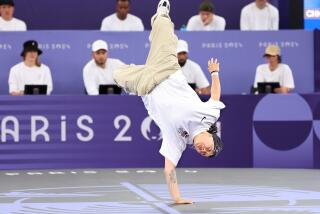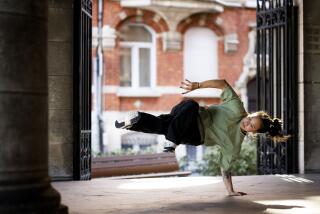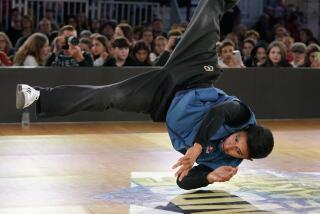Out of the Broom Closet
- Share via
Maybe it’s because the name of the sport prompts visions of little girls getting their hair done. Maybe it’s because one of the key pieces of equipment is a mundane household implement, the lowly broom. Maybe it’s because the game seems to many a combination of bowling and shuffleboard, activities that stand none too tall in the hierarchy of sports.
Whatever the reason, people like to make fun of curling, an Olympic medal sport for the second time in these Salt Lake City Games. After all, there is something, um, different about a game that involves a bunch of polished rocks with handles and is played on a long, narrow sheet of ice with target circles at either end. And speaking of ends, that’s what the playing periods are called.
Do curlers care what people say? Some of the sensitive souls might, but most cock their tams at rakish angles--the sport originated in Scotland--and go about their curling.
Said Tim Somerville, skip--that’s captain--of the U.S. men’s team, “That stuff doesn’t bother me. I’ve played the game awhile.... That stuff doesn’t hurt my feelings one bit.”
Besides, curling is a lot more athletic than some other Olympic sports.
As mentioned, curling originated in Scotland, probably in the 16th century, when farmers curled on the frozen marshes, using what they called “channel stones,” rocks smoothed by flowing water. One player slid a stone across the ice while partners with brooms swept snow from the stone’s path. Scottish immigrants later brought the game to North America, first to Canada, then to the United States--primarily the upper Midwest--and it spread to the European continent as well.
These days, nobody goes out to the marshes to curl. The sport is played indoors, on refrigerated ice in places with locker rooms, snack bars, all the conveniences. If it has a modern look about it, though, it remains true to its roots--rocks and brooms.
Curling involves two teams--they’re called rinks--each with four players. They alternate sliding--curling--the 42-pound granite rocks, each player casting two stones down the 146-foot sheet to a 12-foot target area known as the house. The center of the house is called the tee, and each stone closer to the tee than the opponents’ is good for a point. Since a good shot can be knocked away by an opponent’s shot, the game is full of strategy, offensive and defensive.
It also is truly a team sport, with every player involved in each of his team’s shots. Until it’s his turn to curl, the skip normally stands behind the house, directing his players’ shots. The two other players who aren’t shooting wield the brooms for the one who is, sweeping vigorously to reduce the friction between stone and ice, thus helping the stone along, not quite so vigorously if the rock is proceeding at a higher speed toward the house.
A game consists of 10 ends. When each player from each team has curled his rocks, that’s the end--of that period. Then they turn around and slide their stones back the way they came. It’s not unlike football teams turning around and going the other way after each quarter.
In the Olympics, 10 teams, up from eight last time around, will compete in round-robin play leading to the medal playoffs in each of the men’s and women’s divisions. The U.S., as host nation, will have teams in both but would have qualified anyway on World Championship finishes the last three years. The Somerville rink of Roseville, Minn., the U.S. men’s team, is a veteran group that won four national championships in the ‘90s. Three of the four Somerville curlers were on the U.S. team that finished fourth at Nagano four years ago. Kari Erickson’s national championship rink from Bemidji, Minn., the women’s team, has two Nagano veterans, Debbie McCormick and Stacey Liapis, Erickson’s sister. The U.S. women tied for fifth in 1998.
More to Read
Go beyond the scoreboard
Get the latest on L.A.'s teams in the daily Sports Report newsletter.
You may occasionally receive promotional content from the Los Angeles Times.






